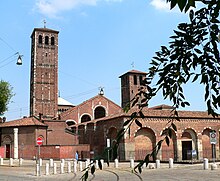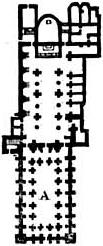
Romanesque architecture is an architectural style of medieval Europe that was predominant in the 11th and 12th centuries. The style eventually developed into the Gothic style with the shape of the arches providing a simple distinction: the Romanesque is characterized by semicircular arches, while the Gothic is marked by the pointed arches. The Romanesque emerged nearly simultaneously in multiple countries ; its examples can be found across the continent, making it the first pan-European architectural style since Imperial Roman architecture. Similarly to Gothic, the name of the style was transferred onto the contemporary Romanesque art.

Cathedrals, collegiate churches, and monastic churches like those of abbeys and priories, often have certain complex structural forms that are found less often in parish churches. They also tend to display a higher level of contemporary architectural style and the work of accomplished craftsmen, and occupy a status both ecclesiastical and social that an ordinary parish church rarely has. Such churches are generally among the finest buildings locally and a source of regional pride. Many are among the world's most renowned works of architecture. These include St Peter's Basilica, Notre-Dame de Paris, Cologne Cathedral, Salisbury Cathedral, Antwerp Cathedral, Prague Cathedral, Lincoln Cathedral, the Basilica of Saint-Denis, Santa Maria Maggiore, the Basilica of San Vitale, St Mark's Basilica, Westminster Abbey, Saint Basil's Cathedral, Antoni Gaudí's incomplete Sagrada Família and the ancient cathedral of Hagia Sophia in Istanbul, now a mosque.

The Papal Basilica of Saint Paul Outside the Walls is one of Rome's four major papal basilicas, along with the basilicas of Saint John in the Lateran, Saint Peter's, and Saint Mary Major, as well as one of the Seven Pilgrim Churches of Rome.

The Euphrasian Basilica or the Cathedral Basilica of the Assumption of Mary is a Roman Catholic basilica in the Istrian town of Poreč, Croatia. The episcopal complex, which comprises the basilica itself, a sacristy, a baptistery and the bell tower of the nearby archbishop's palace, is an excellent example of early Byzantine architecture in the Mediterranean region.
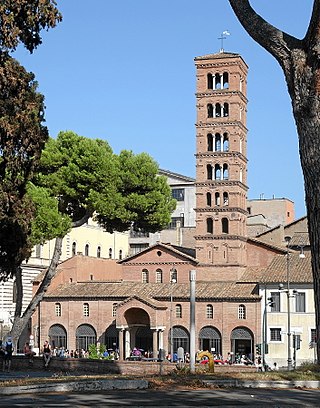
The Basilica of Saint Mary in Cosmedin is a minor basilican church in Rome, Italy, dedicated to the Virgin Mary. It is located in the rione (neighborhood) of Ripa. Constructed first in the sixth century as a diaconia (deaconry) in an area of the city populated by Greek immigrants, it celebrated Eastern rites and currently serves the Melkite Greek Catholic community of Rome. The church was expanded in the eighth century and renovated in the twelfth century, when a campanile was added. A Baroque facade and interior refurbishment of 1718 were removed in 1894-99; the exterior was restored to twelfth-century form, while the architecture of the interior recalls the eighth century with twelfth-century furnishings. The narthex of the church contains the famous Bocca della Verità sculpture.

The Church of St. Trophime (Trophimus) is a Roman Catholic church and former cathedral located in the city of Arles, in the Bouches-du-Rhône Department of southern France. It was built between the 12th century and the 15th century, and is in the Romanesque architectural tradition. The sculptures over the church's portal, particularly the Last Judgement, and the columns in the adjacent cloister, are considered some of the finest examples of Romanesque sculpture.

The Basilica of San Frediano is a Romanesque church in Lucca, Italy, situated on the Piazza San Frediano.
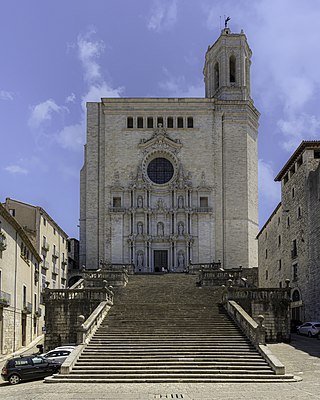
Girona Cathedral, also known as the Cathedral of Saint Mary of Girona, is a Roman Catholic church located in Girona, Catalonia, Spain. It is the seat of the Roman Catholic Diocese of Girona. The cathedral's interior includes the widest Gothic nave in the world, with a width of 23 metres (75 ft), and the second-widest of any church after that of St. Peter's Basilica. Its construction was begun in the 11th century in the Romanesque architectural style, and continued in the 13th century in the Gothic style. Of the original Romanesque edifice only the 12th-century cloister and a bell tower remain. The second bell tower was completed in the 18th century.

The Basilica of Sant'Eustorgio is a church in Milan in northern Italy, which is in the Basilicas Park city park. It was for many years an important stop for pilgrims on their journey to Rome or to the Holy Land, because it was said to contain the tomb of the Three Magi or Three Kings.

The Basilica of San Simpliciano is an ancient Roman Catholic church in the centre of Milan, region of Lombardy, Italy: the church, commissioned by the 4th century bishop St Ambrose, is the second oldest known Christian church with a Latin cross layout. It is dedicated to Saint Simplician, who was Ambrose's successor as bishop of Milan.

The Cathedral of St. Anastasia is the Roman Catholic cathedral of Zadar, Croatia, seat of the Archdiocese of Zadar, and the largest church in all of Dalmatia.

San Babila is a Romanesque-style Roman Catholic church in Milan, region of Lombardy, Italy. It was once considered the third most important in the city after the Duomo and the Basilica di Sant'Ambrogio. It is dedicated to Saint Babylas of Antioch.

Padua Cathedral, or Basilica Cathedral of Saint Mary of the Assumption, is a Catholic church and minor basilica located on the east end of Piazza Duomo, adjacent to the bishop's palace in Padua, Veneto, Italy.
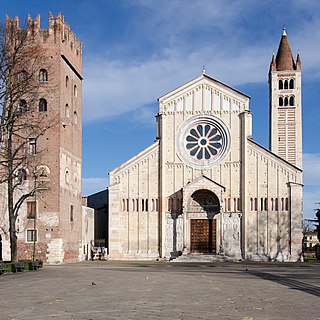
The Basilica di San Zeno is a minor basilica of Verona, northern Italy constructed between 967 and 1398 AD. Its fame rests partly on its Romanesque architecture and partly upon the tradition that its crypt was the place of the marriage of Shakespeare's Romeo and Juliet. It stands adjacent to a Benedictine abbey, both dedicated to St Zeno of Verona.

The basilica of San Nazaro in Brolo or San Nazaro Maggiore is a 4th-century Roman Catholic church in Milan, region of Lombardy, Italy.
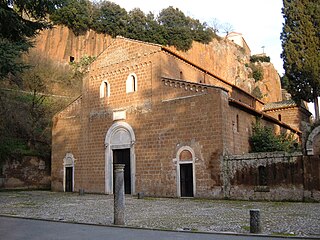
The Basilica di Sant'Elia is a basilica in Castel Sant'Elia, northern Latium, central Italy.

The Basilica of San Fedele in Como is located in the city center. The present Romanesque church dates from 1120 and is dedicated to the Fidelis of Como.

Santa Maria Maggiore is an ancient Romanesque basilica church located at the foot of Colle di San Pietro in Tuscania, Province of Viterbo, Region of Lazio, Italy. Atop the hill is the Basilica of San Pietro.

The parish church of San Giorgio di Valpolicella, also known as the parish church of San Giorgio Ingannapoltron, is an ancient Catholic place of worship located in San Giorgio di Valpolicella, a hamlet of Sant'Ambrogio di Valpolicella, in the province and diocese of Verona; it is also the seat of the parish of the same name included in the vicariate of Valpolicella.
